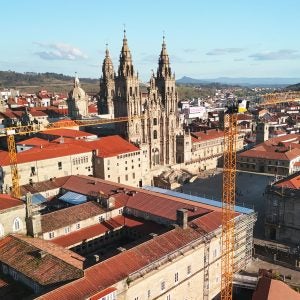After completing a degree in engineering at University of Odense Teknikum, Søren Jansen served three years in the Danish Army, adding two years to his national service obligation to attend the military academy and achieve a commission as lieutenant.
In 1973, he joined Danish Demag Baumaschinen dealer Thomas Schmidt. He worked first as an engineer in the crane department, before moving into the construction equipment division, where his manager was a member of the same army regiment. With his manager’s encouragement, Jansen spent a lot of time in Germany, learning about cranes from Demag’s design engineers and production staff, including training for and taking a crane operator’s licence.
He was promoted to divisional manager of the construction equipment division. After completing a degree at Copenhagen Business School and working for Thomas Schmidt for another two years, he joined PA Consulting, giving him a chance to experience working on his own.
In 1983, he got a call from Eberhard Kuhn at Demag, asking him to run Demag’s US construction equipment division. When he arrived in Chicago, Demag’s business was based on cranes and large hydraulic excavators. Mining shovels were a key part of the business, with parts sales providing a day-to-day living. Demag’s crane business was based on selling large lattice boom cranes to a small number of customers. Roland Hammer was brought in from Germany to head up the company’s US crane sales. Hammer brought with him an extensive knowledge of Demag’s crane carriers, allowing him to handle the discussions with the US Department of Transport and local road regulators needed to get the fledgling truck crane and all terrain sector on the road.
“We made something noone had thought possible,” Jansen says, “We began selling HC and AT type mobile cranes in the US. Only Grove were doing that.”
He went back to working with PA Consulting, becoming a partner in the group. In 1995, he was recruited to head up BMS, Denmark’s largest hirer. BMS had been set up by the Danish government after the war to rent cranes and construction equipment to the small-to-medium sized contractors who couldn’t afford to buy cranes outright, but needed them to help with the country’s reconstruction.
When Jansen joined BMS, it had just merged with its main rival, contractor Monberg & Thorsen’s MT crane rental. Jansen’s first job was handling that merger, and the company’s move into the private sector. It took three years to finish working ‘on the inside of the company’, before pursuing an aggressive plan to grow the company that increased turnover five times.
Working at BMS, Jansen saw many of the same issues coming up that he had faced bringing truck cranes to the US. BMS built its business supporting Denmark’s pioneering wind energy industry. The company moved cranes across Europe, but, for example, when they crossed the border into Sweden, BMS had to unload counterweight blocks from ballast trailers and place them on standard trucks.
In the US, each state had its own permit requirements; in the EU, Jansen says: “We say we want live in a single market, but each country has rules and regulations it won’t pass on to Brussels.”
Since retiring from BMS, this has been Jansen’s focus with ESTA, the association of European national crane and special transport bodies. The group aims to set a level playing field across Europe, harmonising rules and regulations for the crane industry and abnormal load hauliers. On the road side, it is lobbying for the establishment of transport corridors across Europe, allowing cranes to be hired across borders without needing multiple permits. The organisation is working to persuade regulators to take a harmonised approach to issues like axle spacing and loadings.
At ESTA’s last general meeting, in Santorini, Greece, one of the key issues was the French government’s new and very unusual requirement for annual overload testing (something manufacturers say shouldn’t be done with modern cranes). ESTA is surveying members to find out the testing requirements enforced in different member states, and will take the findings to FEM, the European association of lifting equipment manufacturers, asking for a position paper on overload testing.
Relationships with the FEM form the other main part of Jansen’s job with ESTA. This year, he has met with manufacturers ‘four or five times’. Just before this interview, he had returned from a meeting of the industry-wide “Working at Height” group, set up to discuss the safety measures manufacturers will implement on new cranes, and to find ways to ensure personnel know how to use them correctly. As well as manufacturers and hirers, the group includes end clients and regulators from across the EU.
With thirty year’s experience, Jansen has a vision that takes in the scope of the lifting industry. If Europe’s politicians want to build a construction industry that makes of the most of the European single market, they would do well to listen to what Jansen and the rest of ESTA has to tell them.






